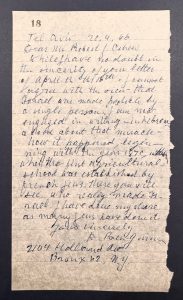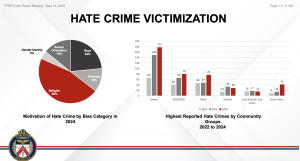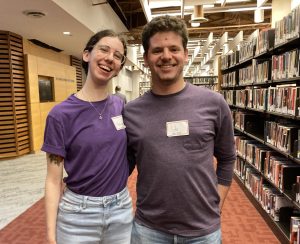 MONTREAL — A gathering to remember Chava Rosenfarb, one of the last of the acclaimed Yiddish novelists, was held last week in Montreal, her home for nearly 50 years. She died in Lethbridge, Alta., Jan. 30 at age 87.
MONTREAL — A gathering to remember Chava Rosenfarb, one of the last of the acclaimed Yiddish novelists, was held last week in Montreal, her home for nearly 50 years. She died in Lethbridge, Alta., Jan. 30 at age 87.
Rosenfarb’s magnum opus was the gritty epic Der boim fun lebn, later translated as The Tree of Life, a 1,000-page fictional work based on the hardships she witnessed in the Lodz Ghetto during World War II. Most of her work, which also includes poetry, stories, essays and plays, concerned the Holocaust or prewar Jewish life.
She was the recipient of Israel’s prestigious Manger Prize in 1979, among other international literary awards.
Born in Lodz, Poland, in 1923, Rosenfarb had lived in Canada since 1950, when she immigrated with her former husband, Dr. Henry Morgentaler, later to become Canada’s foremost abortion-rights activist.
After they divorced in the mid-1970s, she divided her time between Montreal and Melbourne, Australia, with her partner Bono Wiener, a childhood friend, until his death in 1995. In 1998 she moved to Toronto and, in 2003, to Lethbridge, where her daughter, Goldie Morgentaler, is a professor of English at the University of Lethbridge.
Goldie translated several of her mother’s works into English. Some were also translated into Hebrew.
In 2006, Rosenfarb received an honorary degree from the university, making her the first Yiddish writer to be so recognized by a Canadian university.
The daughter of a restaurant waiter and textile factory worker, Rosenfarb grew up in a family devoted to the Jewish Socialist Bund.
As a teenager in the ghetto, Rosenfarb began writing poetry and joined the underground literary milieu. She and her family were deported to Auschwitz in August 1944, from there she, her mother and sister (now Henia Reinhartz of Toronto) were sent to the Sasel labour camp, and finally to the Bergen-Belsen concentration camp, where they were liberated.
Her father, they learned, had been killed on a transport out of Dachau, when the train was bombed by the Americans near war’s end.
After the war, in Brussels, Rosenfarb began working on The Tree of Life, which was eventually published in the original Yiddish in 1972.
“It is one of the few novels, as opposed to memoirs or autobiographies, to be written by an actual survivor of the Holocaust,” her daughter noted. “[It] was immediately hailed as a masterpiece by the Yiddish press, which repeatedly emphasized its unique place in the literature of the Holocaust.”
Rosenfarb was unusual for having achieved status as a Yiddish novelist, traditionally a male domain, and some have argued she was the greatest woman writer of Yiddish ever in any genre. She also brought a realism to her female characters that was not common in the Yiddish canon.
The Manger Prize jury extolled the three-part book as “tower[ing] powerfully over the Jewish literature of the Holocaust.”
The trilogy follows the fates of 10 Jewish inhabitants of the Lodz ghetto, from varied walks of life, from 1939 until its liquidation in 1944. Although fictional, Rosenfarb based the head of the Judenrat (the Nazi-appointed Jewish council) on the real-life Mordechai Chaim Rumkowski, a controversial figure because of the power he wielded.
Despite her wartime experience and half-century of writing, Rosenfarb felt she never adequately communicated the enormity of the Holocaust. “I have very great doubts about whether Holocaust literature is possible,” she said in Montreal in 2004. “Even for a person like myself… what I write is only an echo of the reality.”
For that reason, she avoided any direct depiction of the horrors of the concentration camps.
The Tree of Life was published in English in Australia in 1985 and re-issued from 2004 to 2006 in three volumes by the University of Wisconsin Press.
Rosenfarb began to write seriously after settling in Montreal, a mecca for Yiddish culture. She counted luminaries such as Melech Ravitch, Rochl Korn and J.I. Segal, a generation older than her, as friends. Her first published work was the poetry collection Di balade fun nekhtikn vald (The Ballad of Yesterday’s Forest) in 1947.
Later, with two children, writing had to be confined to the wee hours of the morning. There were other challenges. As Goldie recalled, after her brother was born in 1956, her father, also a Lodz native, decreed that Yiddish was no longer to be spoken at home. Abraham Morgentaler is now a doctor in Boston.
Her second-best-known novel was 1982’s Bociany, the name of an imaginary Polish village and based loosely on the lives of Rosenfarb’s parents. She translated this work herself into English, and it was published by Syracuse University Press, earning her the 2000 John Glassco Prize of the Literary Translation Association of Canada.
A series of short stories written in the 1980s about (mostly female) Holocaust survivors’ often troubled postwar lives in Canada was translated by her daughter and published by Canada’s Cormorant Press in 2004 as Survivors: Seven Short Stories. It won the Helen and Stan Vine Canadian Jewish Book Award.
Morgentaler regrets that her mother’s work is not better known outside the Yiddish-speaking world. “Her fate as a writer thus reflects the general isolation of Yiddish literature from the mainstream of world literature, an isolation that has unfortunately grown more profound with time,” Morgentaler wrote.
At a tribute to her at Concordia University in 2004, Rosenfarb lamented the disappearance of Yiddish literature. “In my 54 years here, a desert has replaced the forest,” and she feared that writing in the mamaloshen would be “dismissed as merely a curiosity.”
“My hope is this treasure will never perish, but bear witness to the spiritual triumph of our people and enrich generations to come.”






